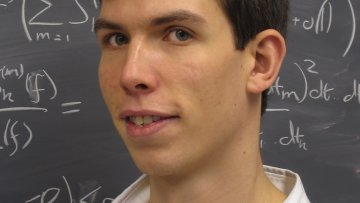Knotted DNA: mathematical models and biological consequences
Oxford Mathematician Dominic Joyce FRS has won the 2016 LMS (London Mathematical Society) Fröhlich Prize "for his profound and wide-ranging contributions to differential and algebraic geometry." Dominic is Professor of Mathematics and Senior Research Fellow at Lincoln College. His research is, in his own words, "mostly in Differential Geometry, with occasional forays into some more esoteric areas of Theoretical Physics."
Oxford Mathematician James Maynard has been awarded a European Mathematical Society Prize at the 7th European Congress of Mathematics in Berlin. The prizes are awarded every four years in recognition of excellence in mathematics to ten individuals under the age of 35 living or working in Europe.
Numerical approximation of heart electromechanics
Please see (https://www.eventbrite.co.uk/e/1st-qbiox-colloquium-tickets-28389665253) for further details
Multiscale modelling of biomolecules: from atomistic molecular dynamics to the continuum limit with fluctuating finite element analysis
Abstract
Atomistic Molecular Dynamics is a well established biomolecular modelling tool that uses the wealth of information available in the Protein Data Bank (PDB). However, biophysical techniques that provide structural information at the mesoscale, such as cryo-electron microscopy and 3D tomography, are now sufficiently mature that they merit their own online repository called the EMDataBank (EMDB). We have developed a continuum mechanics description of proteins which uses this new experimental data as input to the simulations, and which we are developing into a software tool for use by the biomolecular science community. The model is a Finite Element algorithm which we have generalised to include the thermal fluctuations that drive protein conformational changes, and which is therefore known as Fluctuating Finite Element Analysis (FFEA) [1].
We will explain the physical principles underlying FFEA and provide a practical overview of how a typical FFEA simulation is set up and executed. We will then demonstrate how FFEA can be used to model flexible biomolecular complexes from EM and other structural data using our simulations of the molecular motors and protein self-assembly as illustrative examples. We then speculate how FFEA might be integrated with atomistic models to provide a multi-scale description of biomolecular structure and dynamics.
1. Oliver R., Read D. J., Harlen O. G. & Harris S. A. “A Stochastic finite element model for the dynamics of globular macromolecules”, (2013) J. Comp. Phys. 239, 147-165.




